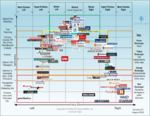I agree with this, and would put in a list including (but not limited to) the following. No particular order, although I think they're all intertwined.
1.
Internet: Allows for people with fringe ideologies to connect and amplify their ideas in subcultures that reinforce radicalizing beliefs. It also makes it easier to research the growing number of shooters and to immerse yourself in their mindset, particularly those who left behind agenda-driven manifestos.
2.
Demographics: I'm broadly generalizing here, but I'd speculate that most people who went to a school where students kept long guns in the parking lot without incident (as I did, also) went to a school that was predominantly rural and white. The presence of weaponry has always been a more volatile ingredient for more urban and/or more diverse populations. Schools themselves are not successfully integrated in the 21st century, but the changing demographics of America overall mean that the guns at schools are less likely to be hunting rifles locked in a pickup all day. One thing that HASN'T changed, though, is that the overwhelming majority of these shootings are carried out by the same demographic who used to not have any problems leaving their rifles in their cars (by which I mean young white males, regardless of political affiliation).
3.
Polarization: The increasingly political nature of all corners of public life mean that 1 & 2 combined are a potent mix.
4.
NRA: The NRA's position of the last few decades that no negotiation is permissible, period, has moved the window of conversation to a point where the solution to guns is *always* more guns. The more that violence is acknowledged as a (if not THE) viable path to ending violence, the more violence itself is normalized. (I think,
@Chucktshoes, that you've acknowledged the same phenomenon with respect to the stance on negotiating gun controls, although you definitely see it from the other side of the fence.)
5.
Complacency: As a corollary to number 4, the more shootings that occur, the more shootings will occur. If we aren't going to do anything as a society to prevent them, they will continue.
6.
Reduction of overall violent crime: as the overall violent crime rate has gone down, the more any one of these events is an outlier relative to the national averages. In conjunction with several of the items above, that means there's a constant push to 'outdo' previous events to continue to make an impact on a culture that is largely de-sensitized to body counts that don't break new ground. It's the gamification of murder, in a way (which is not the same as implying that games are responsible for murder).
Those are just some thoughts off the cuff. The number of guns may very well be a secondary condition and not the underlying primary disease, but that doesn't mean we shouldn't treat it.



